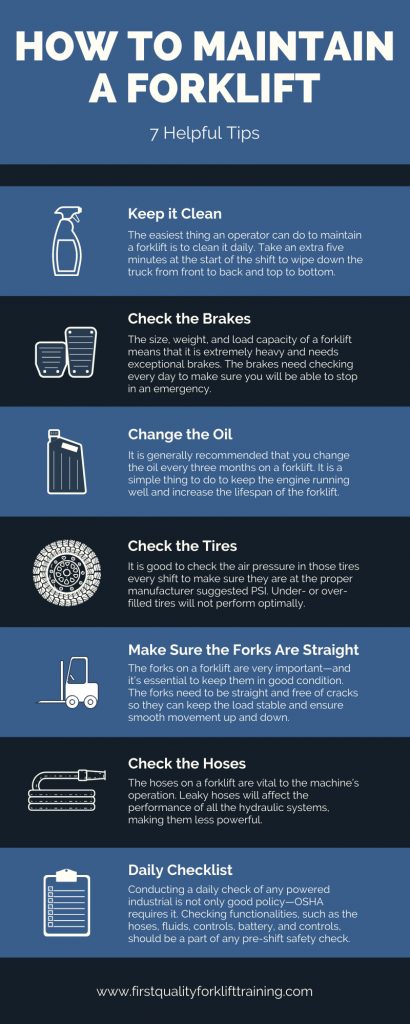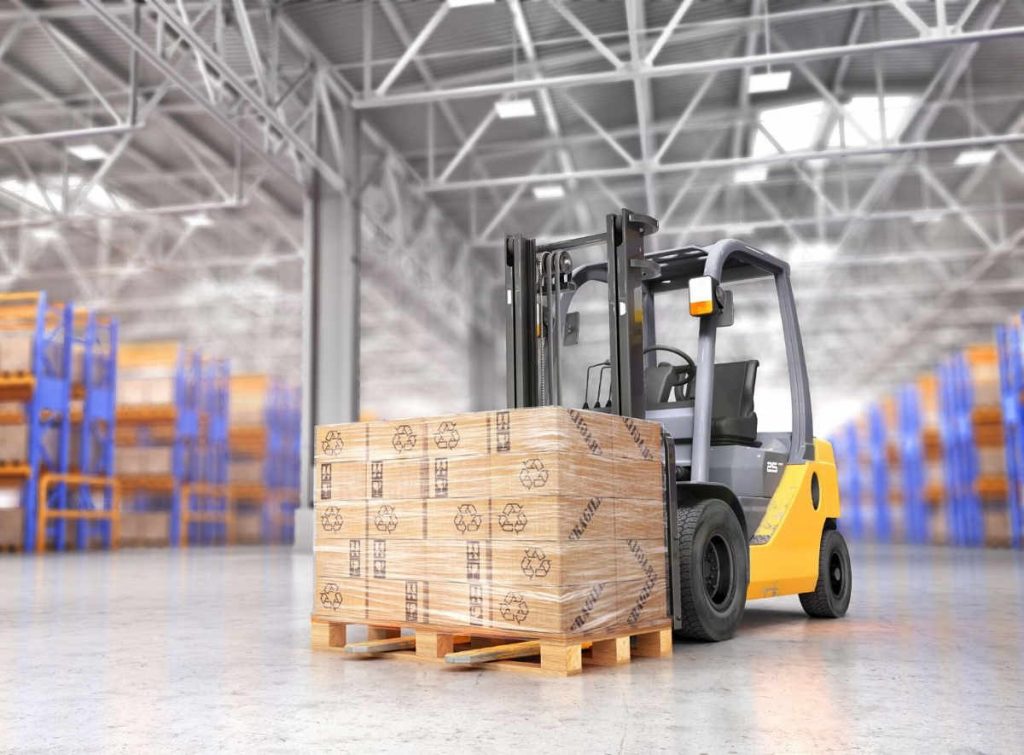Forklift Training
How to Maintain a Forklift: 7 Helpful Tips
Learning and knowing how to maintain a forklift is extremely important for its performance and longevity. Nothing will work perfectly forever if it’s neglected, and machines will operate well if they are properly serviced and maintained. Little tasks, such as cleaning oil and dust off the forklift, will go a long to keep it in working condition and looking good. When not taken care of, a forklift will slowly deteriorate, and the performance will as well.
If there are any malfunctioning systems on the forklift, take it out of service immediately. Follow your company’s lockout/tagout procedure and notify your supervisor about the problems with the truck. No one should drive the truck until all the problems are addressed and repaired. First Quality Forklift Training provides all the necessary operator training for Genie MEWP, JLG MEWP, forklift, and other powered industrial trucks. That way, your team knows what problems to look for on their daily checks and during all their operations.
Keep it Clean
The easiest thing an operator can do to maintain a forklift is to clean it daily. Take an extra five minutes at the start of the shift to wipe down the truck from front to back and top to bottom. Doing this will remove excess oil, dirt, and debris that can work its way into the vital part of the truck and affect the performance. Wiping the truck down will get you up close and personal with it and open your eyes to potential problems you might otherwise miss. It might seem superficial, but a good-looking truck will run well and make the operator feel good and they’ll operate it with an extra sense of pride.
Check the Brakes
Many of the things that you would want to check and have working properly on a car are still applicable to a forklift. They are similar machines with many of the same parts, including their brakes. Just as you wouldn’t drive a car with little to no stopping power, you shouldn’t drive a forklift that operates that way, either. The size, weight, and load capacity of a forklift means that it is extremely heavy and needs exceptional brakes. Note: class I, IV, and V sit-down counterbalance forklifts have brakes only on wheels on the front axle. The brakes need checking every day to make sure you will be able to stop in an emergency. Any issue with the brakes is a serious one. The truck needs taken out of service immediately and repaired if there are indeed any issues with the brakes.
Change the Oil
It is generally recommended that you change the oil every three months on a forklift. It is a simple thing to do to keep the engine running well and increase the lifespan of the forklift. Not changing the oil regularly will lead to poor performance, corrosion, and engine sludge buildup. Regularly changing the oil and oil filter on forklifts is a good practice to keep it running as well as possible.
Check the Tires
The tires on a forklift can wear out quickly, especially if it runs the same path day after day. That kind of repetitive motion can cause the tires to wear unevenly on one side or the other. The tires on an indoor forklift that operates in a warehouse are usually made of rubber molded to a steel band, and they are solid with no air in them. Over time, the tires start to have chunks taken out of them from hitting holes or seams in the concrete. Those missing chunks make for a very bumpy ride and poor performance. Forklifts that are made for outdoor use may have air filled tires (pneumatic), solid rubber or foam filled tires. It is good to check the air pressure for pneumatic tires every shift to make sure they are at the manufacturer’s suggested PSI. Under or over-filled tires will not perform optimally. Note: tire pressure should be the same for tires on the same axle (if not, uneven lifting will occur). A daily check will make sure there are no surprise leaks or flat tires.
Make Sure the Forks Are Straight
The forks on a forklift are very important—and it’s essential to keep them in good condition. The forks need to be straight and free of cracks so they can keep the load stable and ensure smooth movement up and down. The forks attach to the front of the lift (carriage) and will settle into notches. That way, they can sit straight but are still able to move a few inches in either direction. That movement is important for getting under tricky loads cleanly. You want to make sure the forks’ tips are straight and don’t have any jagged or curved edges. Those irregularities can lead to damaging loads when picking them up. The forks are designed to take a decent amount of abuse, that’s why they’re made from solid steel. But even solid steel can absorb too much abuse and not function the way it should. Inspect the forks daily for damage that will negatively impact performance.
Check the Hoses
The hoses on a forklift are vital to the machine’s operation. They are necessary for lifting and moving the loads. Hydraulic fluid runs through the hoses and allows the forks to raise or lower, depending on what controls the operator activates. Leaky hoses will affect the performance of all the hydraulic systems, making them less powerful. Holes in the hoses or bad connections will lead to fluids pooling up on the lift and creating a fire hazard. Make sure they are connected properly and free from holes and cracks. Note: Never try to find a leak with your hand. Use a piece of cardboard to determine if there is a pinhole leak. Failure to follow these rules can lead to the high-pressured hydraulic fluid entering your skin, causing swelling, burning and could lead to amputation or death.
Daily Checklist
Conducting a daily check of any powered industrial is not only good policy—OSHA requires it. OSHA states: Industrial trucks shall be examined before being placed in service and shall not be placed in service if the examination shows any condition adversely affecting the safety of the vehicle. Such examination shall be made at least daily. Where industrial trucks are used on a round-the-clock basis, they shall be examined after each shift. Defects when found shall be immediately reported and corrected. CFR 1910.178(q)(7) A pre-shift checklist of all the major systems and functions of a forklift is the best way to make sure everything is in good working condition. It will make sure the forklift is safe for the operator to use. If during the check there are any failures, the truck should be taken out of service and repaired before being used again. There are standardized checklists published by OSHA, the machine manufacturers and a pre-printed carbon-less booklet, that you can use. Checking functionalities, such as the hoses, fluids, controls, battery, and controls, should be a part of any pre-shift safety check.




I didn’t know that hoses that are leaking can compromise your forklift’s strength which will affect its ability to operate properly. My brother has been thinking about opening a business that distributes auto parts to local businesses, but his forklift has been unable to lift anything ever since he crashed it last weekend. He should find someone that can help fix his equipment.
Thank you for this content. Very helpful.
Thanks for sharing the great information on forklift. Secure your warehouse with a highly designed forklift safety light system
that alerts the pedestrian and enables smooth operation of the forklift.
Thank you for sharing this guide! Well-detailed and precise!